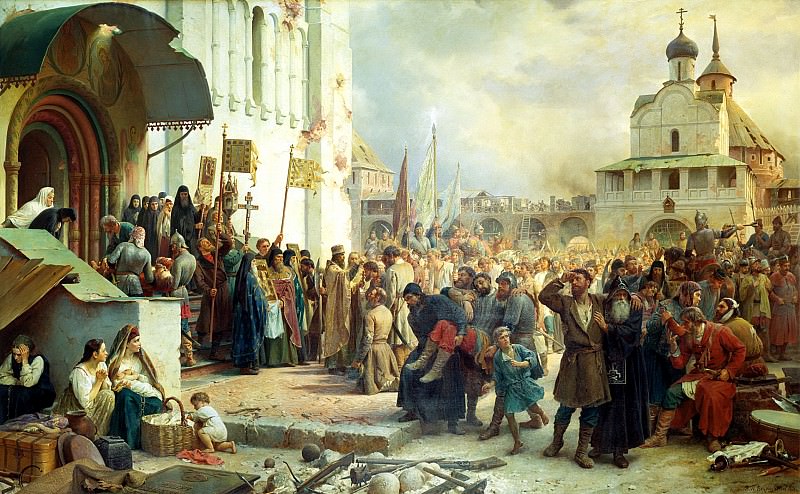Vereshchagin Vasily (Petrovich) – The Siege of the Trinity-Sergius Lavra 900 Classic russian paintings
Vereshchagin Vasily (Petrovich) - The Siege of the Trinity-Sergius Lavra
Edit attribution
Download full size: 2268×1400 px (1,2 Mb)
Back to album: 900 Classic russian paintings
Vasily Petrovich Vereshchagin’s painting The Siege of the Trinity-Sergius Lavra, painted in 1891, depicts one of the most bitter periods in the history of our Motherland. There is no point in telling about the events that took place at that time, dubbed the "Time of Troubles". The painting depicts an episode of storming a monastery, although the viewer does not see battle scenes. Rather the opposite.
Description of Vasily Vereshchagin’s painting The Siege of Trinity Sergius Lavra
Vasily Petrovich Vereshchagin’s painting The Siege of the Trinity-Sergius Lavra, painted in 1891, depicts one of the most bitter periods in the history of our Motherland. There is no point in telling about the events that took place at that time, dubbed the "Time of Troubles". The painting depicts an episode of storming a monastery, although the viewer does not see battle scenes. Rather the opposite. In the foreground, the viewers see the anxious, suffering, frightened, but at the same time spiritualized faces of people who are ready to die, but not to betray the Motherland and the faith.
Indeed, the artist was able to express the meaning of what is happening, using not quite the usual symbols. Unity of the people and clergy in the hour of mourning in the face of the priest carrying the blessing and at the same time the fighting spirit of the defenders of the Lavra, listening carefully to the instructions of the senior and ready to defend their land, all this is carried by the artist slightly in the background of the painting. Compositionally, these elements are located in the left and right parts of the canvas.
The central part of the composition, which doesn’t even immediately catch your eye against the background of the huge Orthodox temple, is a group of defenders of the Lavra, carrying a wounded comrade. Each of these characters represents a different part of society at the time. It was by this combination that the artist wanted to show the unity of all, as it is now customary to say "social groups," against the enemy. If you like, the unification of all Russian people!
At the same time, the sorrow of the central composition does not diminish the positivity of the painting. Despite the general sorrow, it is filled with many symbols that hint at the positive changes to come. At the bottom of the painting, in its very center, the artist has depicted abandoned weapons, suggesting that the war has been imposed from outside. At the same time, the lower left corner of the painting depicts a small, playing child as a symbol of the future peaceful life.
The canvas is painted in light colors, which again speaks to the positive outcome of the grueling siege of the Lavra. The spirituality of the Russian people, their unity in a difficult moment and the bright, albeit cloudy sky of the Motherland - these are the main thoughts that Vasily Petrovich Vasnetsov wanted to convey to the viewer.
Кому понравилось
Пожалуйста, подождите
На эту операцию может потребоваться несколько секунд.
Информация появится в новом окне,
если открытие новых окон не запрещено в настройках вашего браузера.
You need to login
Для работы с коллекциями – пожалуйста, войдите в аккаунт (open in new window).




















You cannot comment Why?
In the foreground, on the left, several women and children are gathered by the church entrance. One woman cradles a baby, while another, in prayerful posture, sits beside her. A young child plays with debris. Their presence introduces an element of vulnerability and civilian suffering amidst the turmoil.
The central part of the composition is dominated by a procession of monks and priests carrying religious icons and banners. They are flanked by men in armor, suggesting a defense or evacuation effort. The expressions on the faces of the crowd are varied, ranging from determined to fearful, highlighting the gravity of the situation. Some are looking towards the background, where the outlines of fortified walls and damaged structures suggest the ongoing conflict.
In the background, the monastery walls are visible, with signs of damage and possibly ongoing fighting. Figures can be seen on the ramparts, and smoke might be implied in the hazy sky, contributing to the sense of danger.
The overall atmosphere is one of desperation and religious devotion in the face of adversity. The juxtaposition of religious symbols and military presence, along with the plight of civilians, underscores the complex nature of the event. The painting likely alludes to a historical event, possibly a siege where the sanctity of the religious site and its inhabitants were threatened. The subtext lies in the endurance of faith and community in times of extreme hardship and violence, as well as the depiction of a pivotal moment in Russias history, emphasizing both spiritual resilience and the brutal realities of conflict.